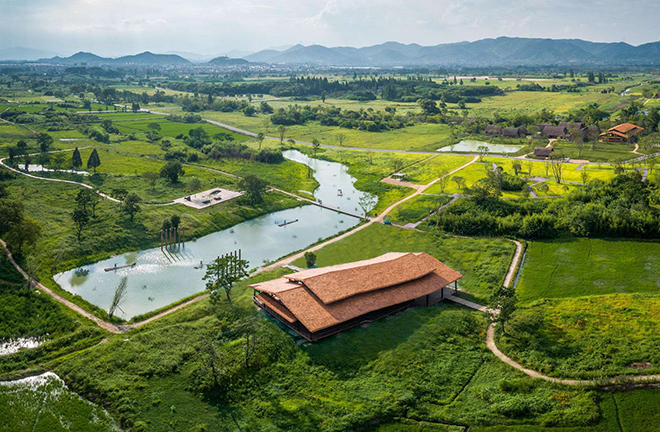Tracing the origins of Chinese civilization showcases cultural confidence

FILE PHOTO: Liangzhu site in Hangzhou, Zhejiang province
Cultivating a profound understanding of the value and significance of Chinese civilization, in world history and in contemporary China, has far-reaching implications.
Emphasizing social differentiation
The most important sign of entering a civilized society is the emergence of the state. Civilization is the sum of material and spiritual civilization created under the state’s jurisdiction. Wang Wei, CASS Member and director of the Academic Division of History at CASS, believes that the primary path of the project to trace the origins of Chinese civilizations is to study social differentiation, and take its emergence as the starting point for origins of civilization. Therefore, 8,000 years ago we see the starting point of the origin of Chinese civilization; and 5,100 years ago, when significant social differentiation occurred and classes, kingship, and early states were formed in the Liangzhu society, was taken as the beginning of entering a civilized society. Together it marks the origin of Chinese civilization.
Based on Chinese archaeological and documentary materials and the development of other ancient civilizations, the definition of civilization established by this project breaks the shackles of the internationally popular “three elements of civilization” (metallurgy, written characters, and cities), and proposes a Chinese rubric for evaluating the criteria of a civilized society, making an original contribution to the study of world civilization origins. Archaeological discoveries in three major cultural sites—Liangzhu, Yangshao, and Hongshan—have confirmed the existence of Chinese culture in the Neolithic period. These have also been confirmed by the international community.
Exploring civilization’s continuity
How has Chinese civilization existed continually? Through historical literature, and by interpreting the code of Chinese civilization’s longevity from Chinese symbols, we explore the secrets of Chinese civilization’s continuity.
Historical literature preserves Chinese civilization, and the profound ideological logic and wisdom of ancient sages permeates the words of classical literature. Later generations annotated and studied the theories of various schools, with Confucianism as the core, in the pre-Qin period (prior to 221 BCE), collectively referred to as “Confucian classics studies.” The “Confucian classics studies” are not only the main body of ancient Chinese academic thought, but also a collection of mainstream ideas on the development of ancient society, and a historical and cultural key to unlocking the code for Chinese civilization’s continuation.
Written symbols are recognized as traces of human civilization’s origin, and mature script is the symbol of cultural memory that unlocks human civilization. Chinese character symbols have a long evolution process. On Nov. 24, 2017, oracle bone inscriptions became the 13th Chinese documentary heritage inscribed on the UNESCO Memory of the World Register.
Chinese characters, which have been passed down for thousands of years, are clear evidence of Chinese civilization’s continuity and have also become messengers of exchanges and mutual learning of the world’s civilizations, and today Chinese characters are one of the six working languages of the United Nations.
Advancing inter-civilization exchanges
Han Jianye, a professor from the School of History at Renmin University of China, said, “Archaeology reveals that Chinese civilization has never been isolated and closed, and that China had limited exchanges with the West through the ‘Road of Painted Pottery Wares’ more than 5,000 years ago. The ‘Silk Road,’ connecting China with Central Asia and Europe, took shape over 2,000 years ago. Cultural exchanges along the road contributed, to a certain extent, to the development of Chinese and Western civilizations.”
In contemporary China, cooperation initiatives proposed by General Secretary Xi Jinping in September and October 2013 to build the “Silk Road Economic Belt” and the “21st Century Maritime Silk Road” employed the ancient Silk Road as a symbol of civilizational interaction to develop in the future. It is a new paradigm of exchange and mutual learning of civilizations by building a community of shared interests, destiny, and responsibility with mutual political trust, economic integration, and cultural tolerance.
Feng Ziyi, a professor from the Department of Philosophy and Religious Studies at Peking University, said that strengthening interaction and exchange of civilizations is an inherent requirement and basic law of civilization development. Interactions rely on the premise of respect and treating each other as equals. The new form of human civilization’s meaning is profound, and it is a re-creation of human civilization, as well as an “upgraded version” of human civilization. Its influence is reflected as human civilization is promoted and led forward into a new era.
Looking into the future of world development, the practical saying “achieving one’s own goal yields gratification, lending a hand to consummate others’ goals doubles satisfaction. Goals of self and others can be unified, thus the world can be harmonized,” exemplifies Chinese civilization, and will surely make new and greater contributions to the diversity of world civilization, building a community with a shared future for mankind, forming common values for humanity, and advancing human civilization.
Edited by ZHAO YUAN
